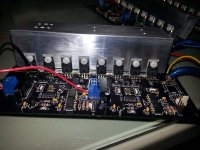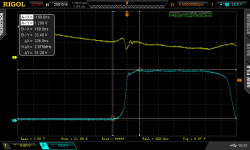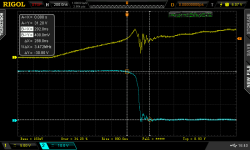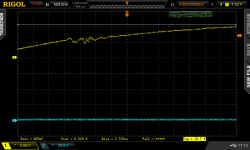So I ordered some Widia taps from McMaster Carr... wow, what a difference. I got lucky and found one of my old good 6-32 tap, but these new Widia taps are even better. I also ordered a T-handle that allows me to do the tapping while using the mill (unpowered) to keep the holes straight. I just received all my goodies today, but I already have all the holes tapped, somewhat straight :lol: Explains why I broke my old good tap... oops.
So due to me lacking proper clamping devices at the time I did this work I mangled the holes a bit, but now it will all fit together, just not as nicely as I had originally planned.
Here are some pictures of the FETs mounted to the heat sinks and also of how they will be mounted inside my 6x6x12" 0.125 wall "enclosure". This thing is going to be shoe box sized, but it is a prototype after all. Good news is it fits on the rear rack of my high speed Cromotor bike without issue so I'll test it on that beast, motor is only 30uH and >17KV. Best load source I have and it's been my standard for testing controllers.
So here is the rough mockup of what I'm doing. It may be ugly, but it should work well. This is what you have to do when you design something without an enclosure in mind.
View attachment 3


Below you can see that each phase get's it's own 6x12" face of the tube as a radiating cooling surface. Attachment is done by six 6-32 bolts on the top of the U channel to help spread the force evenly. Hopefully it works well with a think coat of thermal paste. I'm not a big fan of having the heat having to travel around that 9 degree bend, or that U channel is 0.125 wall vs 0.250 wall, but I needed to make sure everything fit correctly. My original plan of stacking the 3 boards with 50mm spacers just didn't work out as well as I had hoped, but this design is thermally superior to what I originally was going to do, 3x more case surface area is being used and a much shorter path.

Now that I have the proper blocking and clamping kit + a good mill vise, my next heat sink bar should come out much better. Plan is 18 TO-247 FETs on a 1.500 x 1.000 x 7.000" aluminum bar (9 on each side, high side on one, low side on the other with 2 almost direct 1.0uF D-S caps per phase) and then mount the 1.000 face to the top of an aluminum enclosure for thermal dissipation. I'm thinking about going 1.500x1.500 for the extra surface area on the mating face, but it really drives up the 4 layer board cost.
New all SMD driver boards are almost ready to be sent to PCB fab at OSH park. They will be 1 high side, 1 low side with the option of being powered by individual 1W isolated supplies or just two 2W isolated supplies, 1 for high side, the other for the low side. All the same features of this but I'm including the option of the boost stage which will allow up to 15A peaks, if the supply caps can deliver enough current. I've placed spots for 10uF XR7 caps on the board so I'm thinking it will do it. During testing of the this current design I was able to get decent arcing from my gate driver at 15V which surprised me since the power supply is only capable of 67mA at 15V, but the peak current is much higher. Board size is 2.5 wide by 2.5 long, boost transistors bent over so that 3 of these boards can be built into a 3phase sandwich. Screw terminal blocks for connections, twisted wire outputs/inputs. Pretty sure I'm going to make this open source. I need to document how to change the components to fit individual needs, but I already have a spreadsheet that does all the hard math.
I'm not sure how many people will really want to use this gate driver design once it's proven, but from what I've seen on forums so far, gate drivers are the hardest thing to design and have work well, let alone have all the features like my Cadillac driver does. No worries if no one else wants to use it, I did this mainly for myself and HighHopes encourage copying working designs, I do it all the time and I like to give something back.
Before I do all that documenting though I need to get my act together and update my greyborgusa.com website. Business needs to come first and I haven't updated it in a long while, not since I started selling the custom warp ebike frames

I get too wrapped up into this development.








